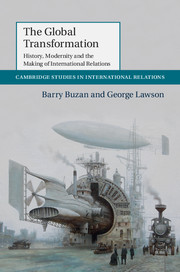Book contents
- Frontmatter
- Dedication
- Contents
- List of Figures
- List of Tables
- Preface
- List of Abbreviations
- Introduction
- Part I The Global Transformation and IR
- Part II The Making of Modern International Relations
- 3 Shrinking the Planet
- 4 Ideologies of Progress
- 5 The Transformation of Political Units
- 6 Establishing a Core–Periphery International Order
- 7 Eroding the Core–Periphery International Order
- 8 The Transformation of Great Powers, Great Power Relations and War
- Part III Implications
- Bibliography
- Index
7 - Eroding the Core–Periphery International Order
Published online by Cambridge University Press: 05 February 2015
- Frontmatter
- Dedication
- Contents
- List of Figures
- List of Tables
- Preface
- List of Abbreviations
- Introduction
- Part I The Global Transformation and IR
- Part II The Making of Modern International Relations
- 3 Shrinking the Planet
- 4 Ideologies of Progress
- 5 The Transformation of Political Units
- 6 Establishing a Core–Periphery International Order
- 7 Eroding the Core–Periphery International Order
- 8 The Transformation of Great Powers, Great Power Relations and War
- Part III Implications
- Bibliography
- Index
Summary
Introduction
In this chapter we stay within the general framing of a core–periphery, Western-global international society. But rather than focusing on how inequality was established and maintained, we turn to the closing of the gap between core and periphery. Again, the underpinning logic is that of the unfolding revolutions of modernity within a framework of uneven and combined development. But, in this chapter, the main driver is not a story of expansion in which a core imposes its mode of power on the periphery. Rather, it is a story of how the revolutions of modernity begin to increase the relative wealth and power of parts of the periphery, narrowly at first, but widening out significantly more recently. At the same time, elements of global modernity changed attitudes within the core, thereby undermining the legitimacy of colonialism. The Second World War was a watershed in this development, with several changes in primary institutions significant enough to mark a transition from Western-colonial to Western-global international society. Much of the chapter is, therefore, devoted to developments after 1945. However, we also find notable elements of the eroding of the power gap in earlier periods.
The logic of uneven and combined development remains strongly evident during this period. Global modernity emerged in a context in which peoples lived in a variety of political, economic and cultural formations, from nomadic bands to city-states and empires. In terms of size, these social orders varied from groups of a few dozen to empires consisting of tens of millions. Some were able to resist or adapt to the assault of modernity; others were consumed by it. At one end of the spectrum were indigenous peoples in settler colonies who were all but obliterated; at the other were those like the Japanese who adapted the modern mode of power to indigenous social formations. In between were a great variety of struggles to come to terms with the challenge presented by the new mode of power, some successful, others less so. This variety meant that the power gap between core and periphery, and the challenge posed by the global transformation to those in the periphery, prompted quite different experiences of modernity.
Information
- Type
- Chapter
- Information
- The Global TransformationHistory, Modernity and the Making of International Relations, pp. 197 - 239Publisher: Cambridge University PressPrint publication year: 2015
